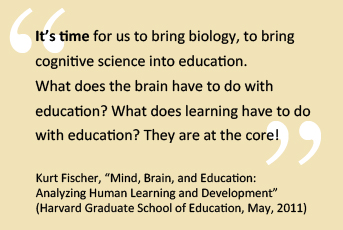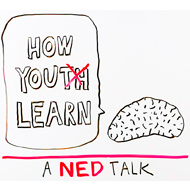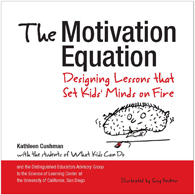

How Youth Learn: A Portfolio to Inform and Inspire Educators, Students, Parents & More
| Motivation and Mastery: Research Highlights | SHARE | |
| SEE ALSO: Conditions of Learning |Mind, Brain & Education |Teenage Brain | Mindsets | Adolescent Development | Social & Emotional Learning |
What makes young people stretch to learn something hard, in school or out? Something they value—perhaps a family tradition passed down, a place among their peers, a curiosity satisfied, a feeling expressed, or a product they make themselves—always gives meaning and momentum to those first steps into learning. Yet that is not enough: They must also expect that they can succeed at the task, with reasonable effort and practice.
|
|
|
Combined, those two factors of value and expectancy lead to both motivation and mastery, research from the learning sciences has long shown (Eccles & Wigfield, 2002). As part of a three-year research project, with youth nationwide serving as co-investigators, What Kids Can Do (WKCD) dubbed this concept “the Motivation Equation” and found it a useful framework in investigating the learning lives of adolescents (UCLA Center for Mental Health in Schools, 2002).
The findings of WKCD’s student researchers matched those of cognitive science experts. They do not think of motivation as an input-output model, in which the teacher uses a particular strategy and the student gets motivated. They set aside the behaviorist orientation, in which positive or negative consequences either reinforce actions or deter them.
Instead, they identified a dynamic web of conditions that influence young people’s desire to achieve. The student’s beliefs, goals, hopes, fears, social contexts, peer and adult relationships, and self-projections into imagined futures all interact to produce a specific action (Toshalis & Nakkula, "Motivation, Engagement, and Student Voice," Students at the Center, 2012).
Social pathways also generate learning
Just as the brain’s neural pathways influence how we process information, so do the social pathways students follow, Toshalis and Nakkula point out. And those pathways too can change and grow.
For example, the social context of some students may predispose them to engage in teacher-directed activity at school. But others may receive the message that their social context marks them as outsiders, for reasons of language, race, socioeconomic class, sexuality, and so forth.
When teachers customize their approaches so that every student feels welcomed and validated at school, students’ capacity and willingness to engage with a challenge both increase. Young people actively generate new knowledge as they build on (or challenge) their own existing structures of meaning.
Self-determination matters to motivation
That dynamic mixture of influences renders the distinction between “intrinsic” and “extrinsic” motivation less useful in the classroom. Instead, supporting students’ experience of their actions as self-determined increases the extent to which they internalize and integrate the expectations of others (Ryan & Deci, 2000).
For example, teachers who afford students more choice in how they reach high academic standards help create an environment that builds both self-determination and motivation in students. The same holds true when students experience meaningful connections with others in an activity, and when they feel reasonable confidence that they can handle the given task.
Not surprisingly, a classroom culture in which intellectual risk-taking is seen as a positive trait will heighten students’ sense that they can expect to succeed at challenging academic tasks. When students regard mistakes as opportunities for learning, they learn more effectively. Rather than brush their errors aside as evidence of incompetence, their brains pay attention to the error and try to learn from it (Bengtsson, Lau, & Passingham, 2009). Developing shame-free routines for help-seeking also supports learners who might otherwise withhold their effort to avoid the humiliation of failure.
New research suggests that the most effective way to approach a challenge is not to tell oneself “I can do this!” but to ask oneself, “Can I do this?” Results after such “questioning self¬-talk” beat out the more declarative style—perhaps because questioning makes explicit the distance between where the learner stands and the desired goal. It forces us to clarify whether we really want something, in spite of the effort it may take (Senay, Albarracín, & Noguchi, 2010).
Mastery comes through practice
Motivation that arises in such ways moves students away from an ego-involved “performance orientation” that keeps them where they can reliably do well, and toward a “learning orientation” that can expand their horizons (Eccles). Teachers support this when they make it possible for learners to look closely at masterful work by others in the field and identify what makes it excellent. If they then use those qualities to help create an assessment rubric for their own efforts, the value they place on mastery often increases.
Breaking the work process down into manageable challenges increases the student’s expectation of success along the road to mastery, completing the Motivation Equation. Here again, respect for the learning process lays a crucial foundation for classroom practice. Teachers inculcate this respect when they establish group norms for constructive critique (Berger, 2003) and when they give students the necessary time for repeated drafts, feedback, revision, self-assessment, and reflection.
Such routines all reinforce new learning through “deliberate practice”—the repeated focus on a particular skill over time, with an express purpose, close attention, and timely feedback (Ericsson, Krampe, & Tesch-Romer, 1993). Not just in athletic and artistic domains but also in academics, deliberate practice provides a highly effective framework for bringing novices to higher performance levels. Bringing the Motivation Equation full circle, the coaching relationship itself supplies a crucial element of the dynamic web of conditions that link motivation with mastery.




